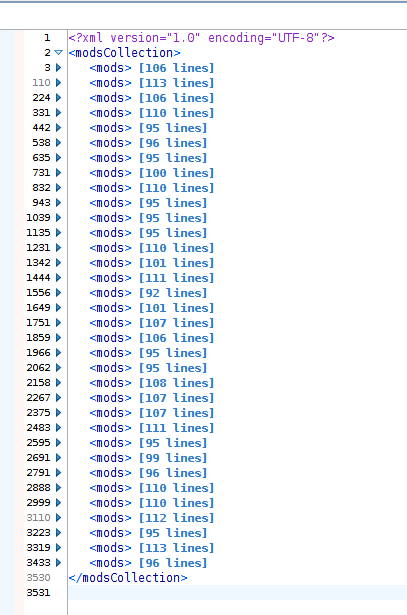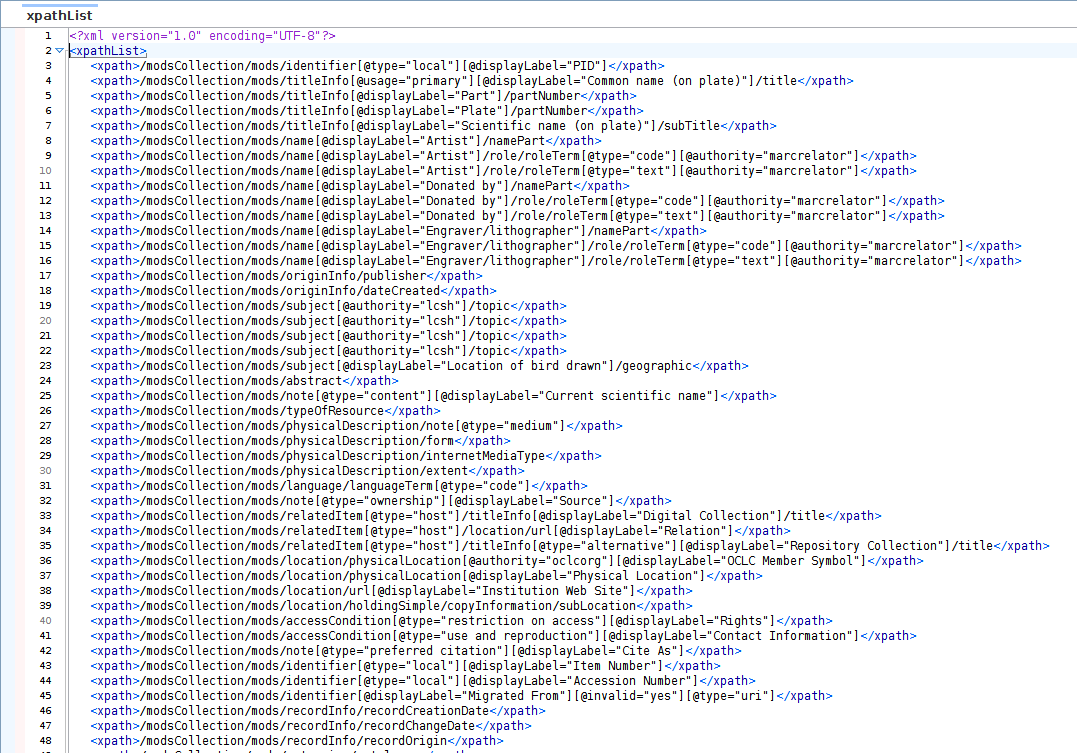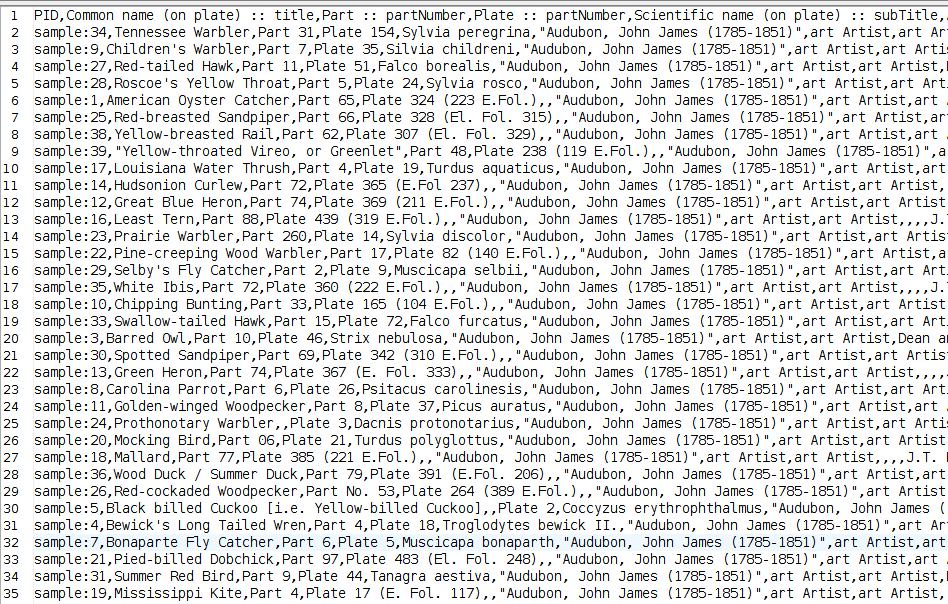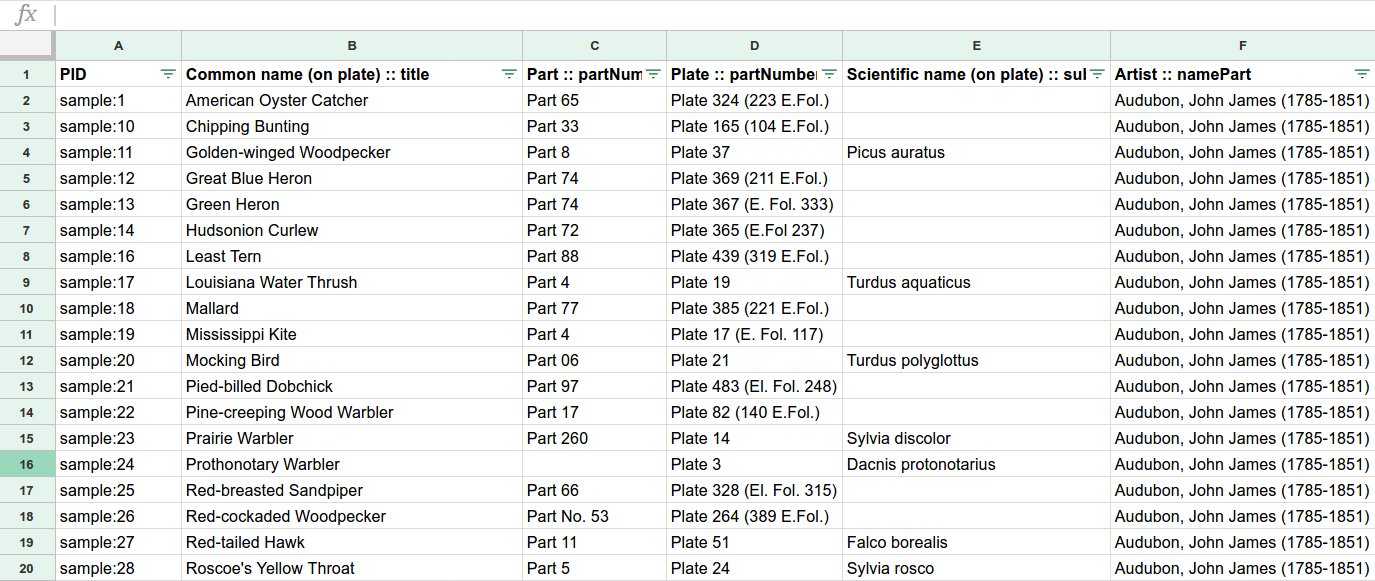This repository includes several XSLT 2.0 stylesheets which combine to convert metadata records in XML format into a CSV document.
Each unique XPath in the source XML will be represented as a separate column in the resulting CSV document. "Unique" here includes not just element names, but also attribute values.
The use case for which this was first developed was the export of MODS records from Islandora (specifically, the Louisiana Digital Library or LDL) and subsequent presentation of the metadata in spreadsheet format for sharing, editing, etc.
- Either XML editing/debugging software such as Oxygen or a command-line XSLT processor such as Saxon is required to run the transforms. Refer to the section on Notes on Processing with Saxon, below.
- While designed with MODS in mind, the xpath_list.xsl stylesheet should work with any well-formed XML document as input, to create a list (in arbitrary XML) of every XPath present in the source document. Note that this is not yet a unique list; the next step, using field_list.xsl, isolates the unique XPaths.
- The metadata sets on which this process was tested were exclusively MODS XML records, and the XSLT herein includes MODS artifacts.
- The MODS metadata sets on which this was tested make heavy use of displayLabel attributes to distinguish specific elements, which is in turn reflected in the XSLT.
- The metadata sets on which this was tested were originally migrated to Islandora from CONTENTdm using the Move to Islandora Kit, and these stylesheets may include remnants and relics of particular data structures from MIK and/or CONTENTdm.
- Batch data cleanup
- Vocabulary reconciliation
- Migration of XML records
- Downloading & sharing collections as data
General workflow is to:
- Export/prepare source XML metadata
- Create a list of all XPaths present in the source document
- Create a list of unique fields present in the source document
- Build a CSV file by evaluating the source metadata document against the field list
The follow-on XSLT stylesheets could have been written to take an arbitrary number of documents; however, having a single source XML file makes QA much more straightforward.
The use case for this process involves the export of metadata records from a digital library using a third party utility. However, there's no reason the later steps wouldn't work with XML from another source -- say, OAI-PMH harvested metadata.
Namespace disagreement problem: Because the XPath list and field list steps are in arbitrary XML, the source XML document should not have a default namespace declaration (e.g. 'xmlns="http://www.loc.gov/mods/v3').
For exporting MODS XML records from Islandora 7.X, we recommend Islandora Datastream CRUD. This utility will produce one MODS XML file per PID.
Merge the multiple MODS XML files into a single "MODS Collection" XML file with a <modsCollection> root element using mods_xml_merge.xsl.
- Usage: With the location of the XML files as the directoryName parameter and the XSLT file itself as the source, run mods_xml_merge.xsl in Oxygen, or at the command line with Saxon:
java -jar saxon9he.jar -s:mods_xml_merge.xsl -xsl:mods_xml_merge.xsl -o:sample_data/sample_mods.xml directoryName=sample_data/input_directory/- The input directory (with its path) is passed in as the 'directoryName' parameter, INCLUDING the trailing slash.
- This stylesheet also adds an
<identifier>element to each MODS record, with the item's PID as its value, derived from the MODS XML filename as formatted by the Datastream CRUD output. - Based on the sample metadata, this stylesheet currently does produce output with a default namespace declaration: '<modsCollection xmlns="http://www.loc.gov/mods/v3>'. Until this can be accounted for in the XSLT, the user must edit the document to remove this declaration (i.e. delete 'xmlns="http://www.loc.gov/mods/v3'.)
The xpath_list.xsl stylesheet reads a source XML file and outputs an arbitrary XML file listing each XPath in the source as a string. In the resulting document, the distinct-values() function may be used to identify unique XPaths.
Note that these strings cannot be substituted for expressions in follow-on XSLT 1.0 or 2.0 stylesheets.
- Usage: With the single XML metadata document as the source, run xpath_list.xsl in Oxygen, or at the command line with Saxon:
java -jar saxon9he.jar -s:sample_data/sample_mods.xml -xsl:xpath_list.xsl -o:sample_data/sample_xpaths.xml
The field_list.xsl identifies the unique XPaths in the source metadata - that is, where both the elements and attributes are distinct. For each unique path, the stylesheet creates a field name to use as the column header in the CSV.
At this point in time, this stylesheet also writes a "mapping" string. Currently, this should be ignored; the intent is that this would be used to create a separate mapping CSV file, as used by the Move to Islandora Kit CSV to MODS Toolchain, to convert the CSV data back to XML records after they were updated.
The output of field_list.xsl can be used for numerous QA applications, such as evaluating consistency in the usage of elements and attributes within a set of metadata.
- Usage: With the output of xpath_list.xsl as the source, run field_list.xsl in Oxygen, or at the command line with Saxon:
java -jar saxon9he.jar -s:sample_data/sample_xpaths.xml -xsl:field_list.xsl -o:sample_data/sample_fields.xml
The field names from the field list will be the column headers. There will be one row of data per metadata record. This XSLT step is written for MODS metadata only, thus far.
- Usage: With the single XML metadata document as the source, and with the output of field_list.xsl as the headerFile parameter, run csv_maker.xsl in Oxygen, or at the command line with Saxon:
java -jar saxon9he.jar -s:sample_data/sample_mods.xml -xsl:csv_maker.xsl -o:sample_data/sample_csv.csv headerFile=sample_data/sample_fields.xml
The resulting CSV file can be opened and edited with a regular spreadsheet-viewing application.
- Namespace disagreement problem -- remove all xmlns="..." from source XML (or alternate solution...?). Acknowledging that this probably strays from best practice, but how else to make the tools generalizable?
- !! Attributes that are paired with or substitute for an element's content (such as @xlink:href or @valueURI) will result in a unique column header for every unique attribute value. Is there any better way than to identify where they exist, explicitly exclude them (at the field_list.xsl stage), and create a separate for them?
- Generally speaking, evaluating the metadata XML document against the list of headers is brittle, tricky, prone to exceptions, and otherwise fraught with peril. Ideally we would be able to evaluate the XML using the full xpaths instead, but alas, as they have been string-ified, this cannot (?) be done with XSLT 2.0 alone.
- Get the distinct values at the XPath List step rather than the Field List step.
- Handling of MODS subject/* elements in CSV: ideal would be to have all subelements within a single wrapper to appear as a single string with double-dash delimiter, with separate strings having a semicolon delimiter.
- (LDL specific issue) Currently the process omits the JSON-encoded CONTENTdm migration data that was brought in as an extension field with MIK.
- RoleTerms are being omitted from the field list because they are disassociated from their names. Current logic does not connect the roleTerm to the namePart except where the roleTerm also shows up in the displayLabel. I intend to customize the name/namePart field to be labeled by and match to sibling roleTerms instead of displayLabels.
- The "elementMatch" function in csv_maker.xsl excludes elements with a displayLabel attribute at the terminal element (to avoid duplicating those elements that do have a displayLabel on other instances; this shows up in the LDL with
<note @type='content'>for example); however, it does not prevent duplication if the label occurs on a container element. - Mapping back from CSV to MODS with MIK
is completely untestedhas been commented out; known issue is that the double quotes in attribute values need to be replaced with apostrophes.
First, be sure to have downloaded Saxon to your local machine. The example commands here (copied from above) assume that it is available from the root of the directory created when you clone this repository. If you downloaded it here, great! Otherwise, it may be useful to make a symbolic link/shortcut from the downloaded unzipped .jar location (shown as /opt/saxon) to this directory, as shown in the first step:
ln -s /opt/saxon/saxon9he.jar saxon9he.jarjava -jar saxon9he.jar -s:mods_xml_merge.xsl -xsl:mods_xml_merge.xsl -o:sample_data/sample_mods.xml directoryName=sample_data/input_directory/java -jar saxon9he.jar -s:sample_data/sample_mods.xml -xsl:xpath_list.xsl -o:sample_data/sample_xpaths.xmljava -jar saxon9he.jar -s:sample_data/sample_xpaths.xml -xsl:field_list.xsl -o:sample_data/sample_fields.xmljava -jar saxon9he.jar -s:sample_data/sample_mods.xml -xsl:csv_maker.xsl -o:sample_data/sample_csv.csv headerFile=sample_data/sample_fields.xml
Saxon HE is on SourceForge, somewhere like this: https://sourceforge.net/projects/saxon/files/Saxon-HE/9.8/




